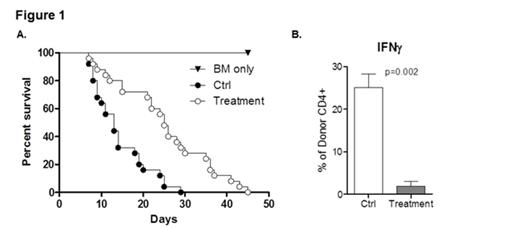Abstract

The particular subsets of T cells that mediates aGvHD is not clear. Several studies have implicated Th1 and/or Th17 T cells in the pathogenesis of aGvHD. Pre-clinical data suggest that IFN-γ producing Th1 cells are perhaps more important for GI tract aGvHD whereas IL-17 producing Th17 cells are more important for skin and lung pathology. However, both murine models and clinical data indicate that suppression of Th1 and Th17 responses by shifting to a Th2 T cell phenotype limits aGvHD. One potential mechanism for the enhanced Th1 tropism of the lower GI tract is the role of conditioning therapy on the release of cytokines and bacterial products that may polarize naïve T cells toward Th1 cells.
The explosion of data surrounding innate immune cells, such as type 2 innate lymphoid cells (ILC2) has increased the possibility of discovering additional candidate suppressive cells. In patients undergoing allo-HCT, peripheral blood ILCs slowly recover and activated ILCs are associated with reduced GVHD lethality. Since ILC2 cells may drive donor Th2 responses that reduce GVHD lethality and hence their deficiency may predispose to Th1 mediated GVHD, we quantified ILC2 numbers in the GI tract and secondary lymphoid organs after radiation. B6D2 mice were given a lethal dose of radiation and ILCs enumerated using flow cytometry. As shown by others, ILC3 cells in the lamina propria (LP) of the colon are resistant to radiation but CD4+ T cells in the LP, spleen and MLN are sensitive to radiation showing significant reduction of total cells within 24 hrs. In striking contrast to ILC3 cells, ILC2 cells from the LP of the colon and spleen were highly sensitivite to radiation. Thus, the absence of recipient ILC2 cells in the colon and MLN, may critically lead to alterations in the microenvironment leading to Th1 polarization in the lower GI tract induced after allo-SCT.
Given ILC2 production of Th2 cytokines and the data indicating that shifting the cytokine micro-environment away from Th1/Th17 to Th2 reduces the severity of aGVHD, we hypothesized that co-transplantation of ILC2 cells would reduce aGvHD and increase survival after allo-SCT. ILC2 cells can be indentified as lin- and ICOS+, CD127+ and ST2+. ILC2 cells were expanded for 6 days in the presence of IL-7 and IL-33 which resulted in increased percentages of IL-4, IL-5 and IL-13 expressing cells with no evidence of expansion of other ILC groups based upon IFN-γ expression for ILC1 or IL-22 expression for ILC3 cells.
To test the efficacy of restoring ILC2 cells after radiation, we performed survival studies in two distinct aGVHD models. In the B6 to BALB/c models of aGvHD after allo-SCT, co-transplantation of one dose of ILC2 cells significantly improved survival after allo-SCT (p<0.0001 log rank) (Figure 1A) with an increase in median survival of 12 days and a reduction in clinical GvHD score (Day 20 score, 6.5 ± 0.3 vs. 3.5 ± 0.4 SEM), beginning at day 10 in a very stringent MHC completely mismatched model. An even greater improvement in survival was seen with ILC2 infusion at the time of transplant in B6D2F1 recipients of B6 bone marrow and T cells. In the B6 to BALB/c model, analysis of donor T cells cytokine production by flow cytometry showed a significant reduction in the frequency of IFNγ producing CD4+ T cells in the LP of recipients of ILC2 cells (Figure 1B). Interestingly, we found that ILC2 cells were equally effective in the complete mismatch model when given on the day of transplant or seven days after transplant.
In summary, we have shown that ILC2 cells are radiation sensitive and that co-infusion of a single dose of ILC2 can increase survival, reduce clinical signs of aGvHD and reduced Th1 cytokine production by donor T cells. These data suggest that the Th1 skewed microenvironment in target organs of GvHD seen after conditioning therapy may be due to reduce ILC2 numbers and replacing the ILC2 population with donor-derived cells in the transplant recipient returns the immune microenvironment to a more desirable, tolerogenic status.
No relevant conflicts of interest to declare.
Author notes
Asterisk with author names denotes non-ASH members.

This icon denotes a clinically relevant abstract


This feature is available to Subscribers Only
Sign In or Create an Account Close Modal